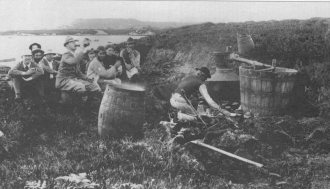
For our nineteenth century ancestors July was the month when food was at its scarcest. By the time that July arrived food from the previous harvest had sustained households over most of the previous year, and many families found that their stores of food were much depleted or had disappeared entirely at this late stage. The decline in living standards, present throughout nineteenth century Ireland, would peak during the Famine which would eventually take a million lives and force a further million of Irish men and women to emigrate from the land in which they were born. Many of whom would never return to the land of their ancestors. For families who had cattle, running out of stored crops was not as lethal, but for the quarter of the population, that relied on the potato as their sole source of sustenance, July would be to varying degrees a difficult month to get by – even without the devastation of famine.
These tough conditions gave July many alternative names including, most generally, “The Hungry Month”, ‘The Blue Month’ and ‘Staggering July.’ Other names for July appear to have been more regional: Amhlaoibh Ó Súilleabháin, who was living near Callan in the County of Kilkenny in the early decades of the nineteenth century, recorded in his diary that July was known as Buímhís ‘The yellow month” in reference to both the colour of fields and the faces of the poor during this month. While in the latter half of the nineteenth century Charles McGlinchey recalled that the heat alone was reason enough to give the first half of July and the second half of August the dark nickname Mí Mharbh “The Dead Month” in reference to the stifling heat that accompanied this sultry season.
If July was a month for hunger and stifling heat it was, at least in eastern Donegal, also a month for thirst; as the opening days of July provided the people of the Inishowen peninsula with a unique opportunity to produce poitín – a strong alcoholic drink made from cereals or potatoes, unnoticed by the local authorities. As the distilling of poitín illegal it was often traditionally made on away on islands or in difficult to reach areas to approach. But distance was not the only consideration in the minds of these distillers; the great plumes of smoke that were released while distilling their ‘Uisce Beatha,‘ literally water of life, made their task to carryout their secular vocations. There was a man named Dolty MacGarvey who lived in the small village of Glen in the early 1870s who explained to William Le Fanu the seasonal strategy that local poitín distillers used to avoid detection form the British authorities; ‘we always dry the malt in the beginning of July, when all the police are taken off to Derry to put down the riots there ; so we can do it safely then. God is good, sir ; God is good.’
Sources
Danaher, Kevin. The Year in Ireland. Dublin 1972.
Evans, E. Estyn. Irish Folk Ways. London, 1957.
Le Fanu, William Richard. Seventy Years of Life in Ireland, 1893
Mc Glinchey, Charles. The Last of the Name. Edited by Brian Friel. Belfast, 1986.
Ó Súilleabháin, Amhlaoibh. The Diary of an Irish Countryman 1827 – 1835. Translated from the Irish by Tomás de Bhaldraithe. Cork/Dublin 1970/1979.
Reblogged this on thefadingyear.
LikeLike
Really good article, thanks. When I was writing my thesis on poor relief in medieval English monasteries, it was noticeable how the accounts showed a great increase in monastic distributions of bread in July, which dropped off dramatically after the harvest in August. This happened almost every year where the data was available (c.1250-1540). It was sometimes called ‘The Low Time.’
LikeLike
Wow thanks for that Neil, that’s really interesting. Love all the names that July is getting – the Low Time is new to me
LikeLiked by 1 person